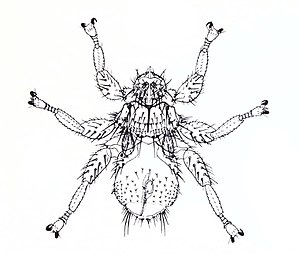Streblidae
| Streblidae | ||||||||||||
|---|---|---|---|---|---|---|---|---|---|---|---|---|

Mastoptera guimaraesi |
||||||||||||
| Systematics | ||||||||||||
|
||||||||||||
| Scientific name | ||||||||||||
| Streblidae | ||||||||||||
| Kolenati , 1863 |
Streblidae (often also referred to as bat flies ) represent a family of the two-winged (Diptera). Within this they are assigned to the flies (Brachycera). Around 250 species of bat flies are known worldwide, mainly native to the tropics and subtropics. Only the species Brachytarsina flavipennis occurs in southern Europe. The animals are small and reach a body size of a few millimeters.
The bat flies are often wingless, with some species also having very well-developed wings and being good fliers. The hips ( coxes ) of the animals are shifted very far on the back, whereby the legs are spread wide. In the rest position, the head is not laid back on the thorax as in the bat flies of the Nycteribiidae family. The eyes are also largely regressed or completely absent. The attachment to the host is facilitated by several bristle combs and bristles on the body . The skin of bat flies is very tough, so that it is hardly possible to crush the animals with your fingers.
The Streblidae parasitize as ectoparasites on bats and feed on the blood of their hosts. To do this, they hold on to the fur of the animals. In some species the host specificity is very pronounced.
Especially the representatives of the genus Ascodipteron ( Australia , India , Africa ) are extremely well adapted to their hosts. They initially have wings, which they shed when the host is found. There they burrow using the mouthparts into the skin of the hosts and transform into a bag-like structure, which breathes through the Einbohrstelle and releases the larvae.
Systematics
The Streblidae are often combined with the bat flies of the Nycteribiidae and the actual louse flies (Hippoboscidae) to form the louse flies in the broader sense (pupipara). All three groups give birth to larvae that pupate immediately after birth (adenotrophic viviparity ).
- Family: Streblidae
- Subfamily: Ascodipterinae
- Subfamily: Brachytarsininae
- Subfamily: Nycteriboscinae
- Subfamily: Nycterophiliinae
- Subfamily: Streblinae
- Subfamily: Trichobiinae
The Streblidae may not be monophyletic . The subfamily Trichobiinae with the Nycteriboscinae and other lines could be more closely related to the bat flies of the Nycteribiidae. Several authors prefer a division into a New World group (Ascodipteridae as proposed) consisting of Ascodipterinae and Nycteriboscinae on the one hand, and an Old World group (keeping the previous name Streblidae) with all other subfamilies on the other. Alternatively, the Streblide and Nycteribiidae could be combined into a monophyletic family, which then includes all bat flies.
literature
- Joachim Haupt, Hiroko Haupt: Flies and Mosquitoes. Observation, way of life , Natur-Verlag, Augsburg 2001, ISBN 3-89440-278-4
- Klaus Honomichl, Heiko Bellmann : Biology and Ecology of Insects , (1 CD-ROM), Fischer, Stuttgart 1996, ISBN 3-437-25020-5 (Book edition: Fischer, Stuttgart 1998, ISBN 3-437-25890-7 )
Web links
Individual evidence
- ↑ Frederik Torp Petersen, Rudolf Meier, Sujatha Narayanan Kutty, Brian M. Wiegmann et al .: The phylogeny and evolution of host choice in the Hippoboscoidea (Diptera) as reconstructed using four molecular markers . In: Elsevier (Ed.): Molecular Phylogenetics and Evolution . 45, No. 1, The Netherlands, 2007, ISSN 1055-7903 , pp. 111-122. doi : 10.1016 / j.ympev.2007.04.023 . PMID 17583536 .